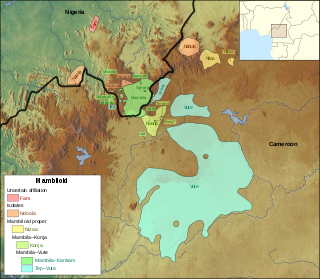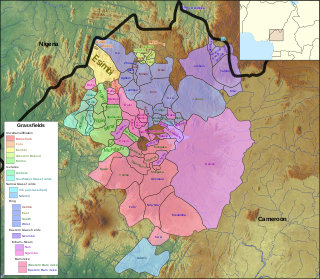Related Research Articles
The Yeni language is an extinct language of Cameroon, formerly spoken around Djeni Mountain in the Nyalang area. All that remains of the language, apparently, is a song remembered by some Sandani speakers. However, according to Bruce Connell, comparison of the song's words to neighboring languages suggests that "it was closely related to [the Mambiloid languages] Cambap, Njerep, and Kasabe."
The Mambilla or Mambila people of Nigeria live on the Mambilla Plateau. A small fraction of Mambilla migrants left the Mambilla Plateau for the Ndòm Plain on the Cameroon side of the international border as well as in a couple of small villages, such as New Nàmba, on the Gashaka Plain in the north, and Jiini-Nyalang-Langa area close to the Kwanja. The Mambilla also occupy the Nyorrong-Lii-Ngùum area of Cameroon and are traceable in history to the Bang District of Mambilla Plateau. Today, the preferred ethnonym is spelt Mambila in Cameroon and Mambilla in Nigeria. "Norr" is also used.
Baldemu, or Mbazlam, is a nearly extinct Afro-Asiatic language spoken in northern Cameroon. Baldamu is spoken in Bogo commune, Diamaré department, Far North Region by only 5 speakers as of 2012. Speakers have been shifting to Fulfulde.

The twelve Mambiloid languages are languages spoken by the Mambila and related peoples mostly in eastern Nigeria and in Cameroon. In Nigeria the largest group is Mambila. In Cameroon the largest group is Vute.
The Nimbari language, which is no longer spoken, was a member of the Leko–Nimbari group of Savanna languages. It was spoken in northern Cameroon. Ethnologue lists Badjire, Gorimbari, and Padjara-Djabi villages as Nimbari locations in Bénoué and Mayo-Louti divisions.
Wawa is a Mambiloid language spoken in a region of Cameroon and just inside bordering Nigeria used by about 3,000 people in three main dialects.
Mbule, also called Dumbule or Mbola, is an endangered Southern Bantoid language spoken by a few people in central Cameroon.
Mambila is a dialect chain stretching across Nigeria and Cameroon. It is one of the Mambiloid languages, a branch of Benue–Congo.
Tikar is a Northern Bantoid, semi-Bantu language that is spoken in Cameroon by the Tikar people, as well as by the Bedzan Pygmies, who speak their own dialect of the language. A recent hypothesis by Roger Blench suggests that the Tikar language could be a divergent language in the Niger-Congo language family with an uncertain origin.
Iyasa is a Bantu language spoken in Cameroon and Equatorial Guinea by the Iyasa and Ndowe coastal fishing peoples. It is also spoken by Pygmies, perhaps Babongo, in Gabon. Approximately 3,000 people speak Iyasa, though some note that this number may be an overestimation.
Ndoola (Ndoro) or Njoyamɛ in Cameroon is a Bantoid language of Nigeria, with several thousand speakers in Cameroon. It is either among or related to the Mambiloid languages.
Kwanja (Konja) is a Mambiloid language of Cameroon. Njanga (Nyanjang) is a distinct dialect.
Mbongno (Bungnu), also known as Kamkam, is a Mambiloid language of Nigeria, with an unknown number of speakers in Cameroon.
Somyev (Somyewe), also known as Kila, is a nearly extinct Mambiloid language of two villages, one in Nigeria and one in Cameroon, that is spoken by a caste of blacksmiths that live among the Mambila. Although the language is still used for daily communication, the youngest generation of speakers were born in the 1950s. Transmission of the language ceased when the profession of blacksmithing lost its social status, partly due to imports of foreign tools.

Babanki, or Kejom, is a Bantoid language that is spoken by the Babanki people of the Western Highlands of Cameroon.
Njerep (Njerup) is a Mambiloid language spoken in the Adamawa Region of Cameroon. Njerep is essentially extinct, with only 4 people who speak it at home. Though word lists and grammatical information have been collected from these people, the information remains fragmented.
Twendi, or Cambap as it is also known, is a nearly extinct Mambiloid language of Cameroon. Speakers have largely shifted to the closely related language Kwanja, and Twendi has not been passed down to children for decades. The language is spoken in the villages of Cambap and Sanga on the Tikar Plain by no more than 30 people, the youngest of whom were born in the 1940s.
Mahongwe is an undocumented and threatened Bantu language spoken in Gabon. The Mahongwe language is a language spoken by the Mahongwe people, belonging to the Bantu ethnic group, who mainly reside in the central Gabon region. It is one of several Bantoid languages spoken in the Central African region.
The Kasabe language is an extinct language of Cameroon, formerly spoken around Mambila in the Nyalang area. The last speaker, a man named Bogon, died on 5 November 1995.
Ndola People are found in Taraba, Nigeria and located in Kurmi and Ngada. Few are also found in Cameroon.